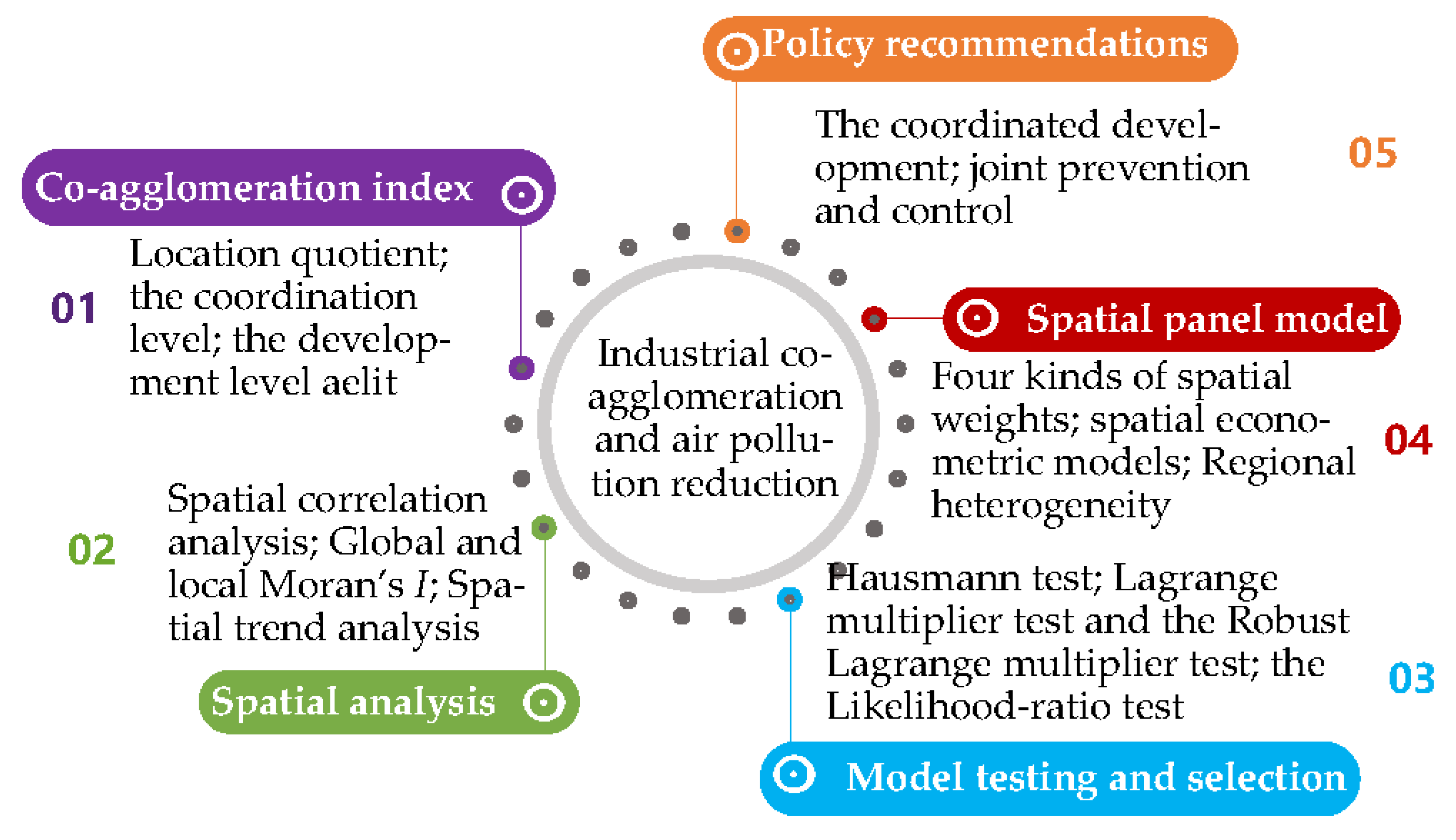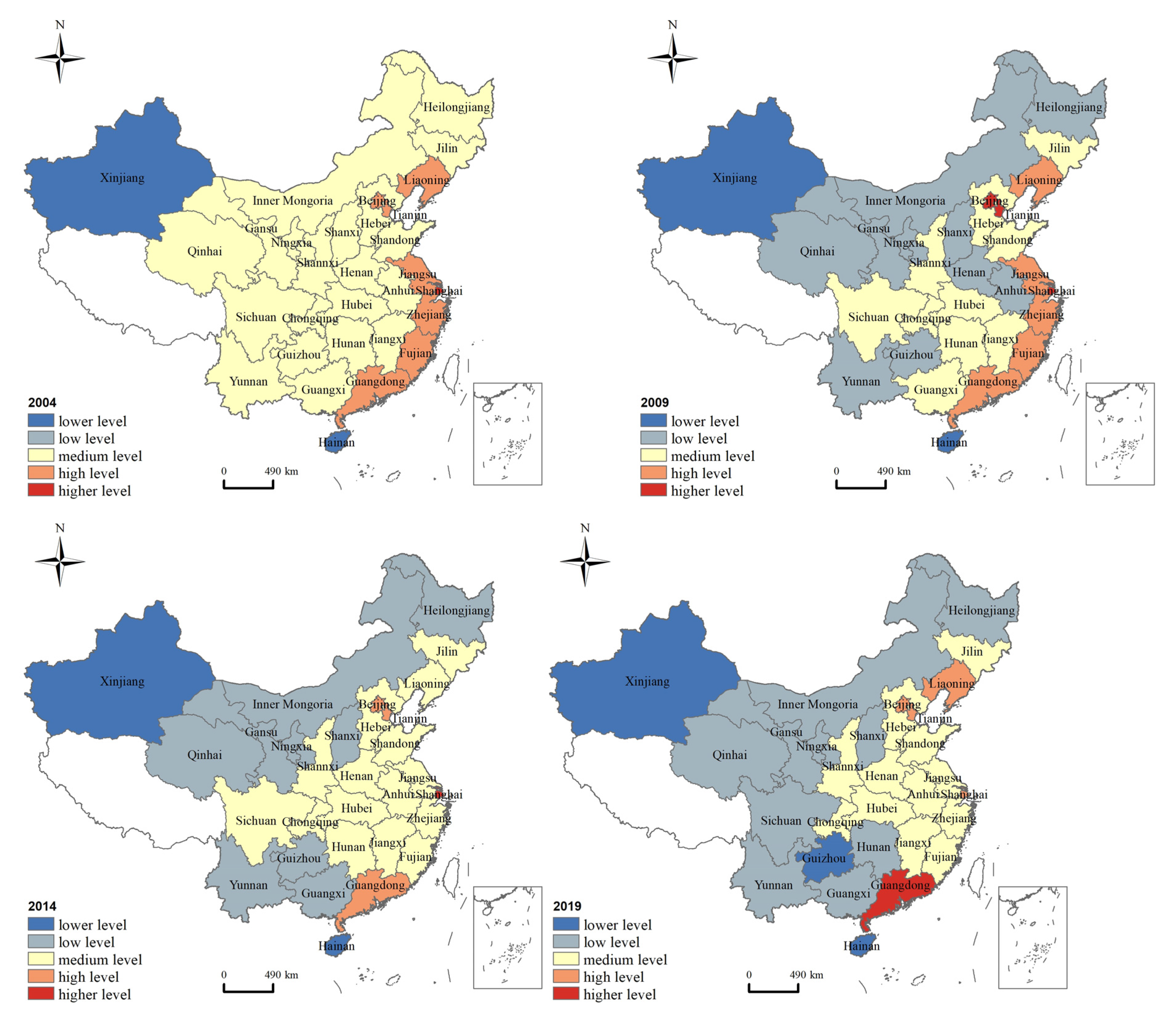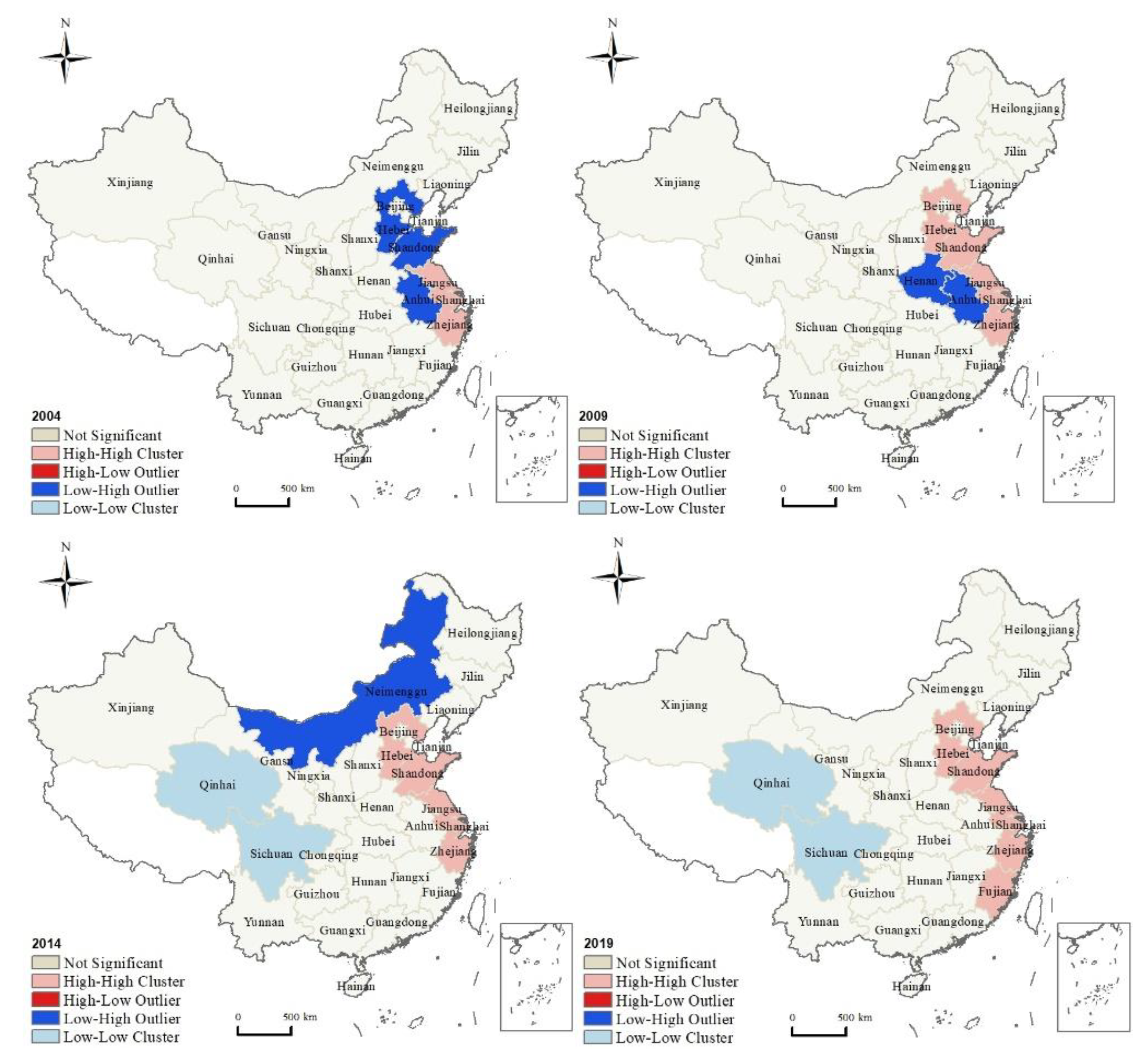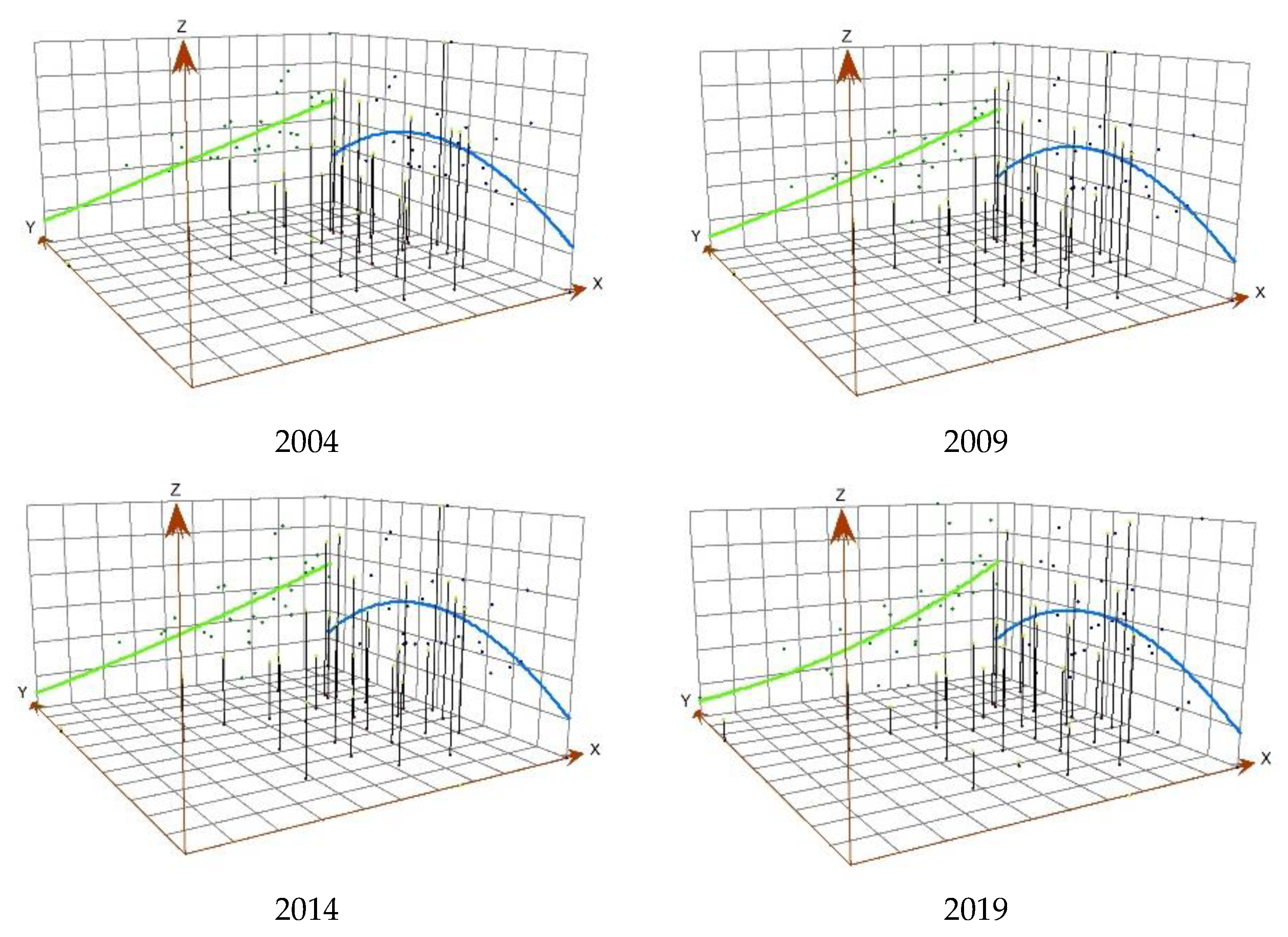Industrial Co-Agglomeration and Air Pollution Reduction: An Empirical Evidence Based on Provincial Panel Data
Abstract
:1. Introduction
- (1)
- What are the spatio-temporal characteristics of the co-agglomeration between manufacturing and producer services in China?
- (2)
- How does the industrial co-agglomeration affect air pollution?
- (3)
- Are there spatial spillover effects and regional differences in the impact of co-agglomeration on air pollution?
2. Theoretical Analysis and Research Hypothesis
3. Methods and Data Sources
3.1. Co-Agglomeration Index
3.2. Spatial Correlation Analysis
3.3. Spatial Trend Analysis
3.4. Construction of the Spatial Econometric Model
3.4.1. Model Specification
3.4.2. Variable Descriptions
3.5. Data Sources
4. Temporal and Spatial Characteristics
4.1. General Characteristic Analysis
4.2. Spatial Correlation Analysis
4.3. Spatial Trend Analysis
5. Empirical Results
5.1. Model Selections
5.2. The Baseline Regression Results
5.3. Analysis of Regional Heterogeneity
5.4. Robustness and Endogeneity Test
6. Conclusions and Discussions
Author Contributions
Funding
Institutional Review Board Statement
Informed Consent Statement
Data Availability Statement
Conflicts of Interest
References
- Lu, J.Y.; Tao, Z. Industrial agglomeration and co-agglomeration in China’s manufacturing industries: With international comparison. Econ. Res. J. 2006, 3, 103–114. [Google Scholar]
- Liu, X.P.; Zhang, X.L. Industrial agglomeration, technological innovation and carbon productivity: Evidence from China. Resour. Conserv. Recycl. 2021, 166, 105330. [Google Scholar] [CrossRef]
- Zeng, W.P.; Li, L.; Huang, Y. Industrial collaborative agglomeration, marketization, and green innovation: Evidence from China’s provincial panel data. J. Clean. Prod. 2021, 279, 123598. [Google Scholar] [CrossRef]
- Ke, S.Z.; He, M.; Yuan, C.H. Synergy and co-agglomeration of producer services and manufacturing: A panel data analysis of Chinese cities. Recess. Recov. Resili. 2014, 48, 1829–1841. [Google Scholar] [CrossRef]
- Chen, C.F.; Sun, Y.W.; Lan, Q.X.; Jiang, F. Impacts of industrial agglomeration on pollution and ecological efficiency—A spatial econometric analysis based on a big panel dataset of China’s 259 cities. J. Clean. Prod. 2020, 258, 120721. [Google Scholar] [CrossRef]
- Hong, Y.; Lyu, X.; Chen, Y.; Li, W. Industrial agglomeration externalities, local governments’ competition and environmental pollution: Evidence from Chinese prefecture-level cities. J. Clean. Prod. 2020, 277, 123455. [Google Scholar] [CrossRef]
- Nielsen, B.B.; Asmussen, C.G.; Weatherall, C.D.; Lyngemark, D.H. Marshall vs Jacobs agglomeration and the micro-location of foreign and domestic firms. Cities 2021, 117, 103322. [Google Scholar] [CrossRef]
- Carlei, V.; Nuccio, M. Mapping industrial patterns in spatial agglomeration: A SOM approach to Italian industrial districts. Pattern Recognit. Lett. 2014, 40, 1–10. [Google Scholar] [CrossRef]
- Drucker, J.; Feser, E. Regional industrial structure and agglomeration economies: An analysis of productivity in three manufacturing industries. Reg. Sci. Urban Econ. 2012, 42, 1–14. [Google Scholar] [CrossRef]
- Kim, Y.R.; Williams, A.M.; Park, S.; Chen, J.L. Spatial spillovers of agglomeration economies and productivity in the tourism industry: The case of the UK. Tour. Manag. 2021, 82, 104201. [Google Scholar] [CrossRef]
- Yang, Z.S.; Song, T.; Chahine, T. Spatial representations and policy implications of industrial co-agglomerations, a case study of Beijing. Habitat Int. 2016, 55, 32–45. [Google Scholar] [CrossRef]
- Lu, W.; Tam, V.W.Y.; Du, L.; Chen, H. Impact of industrial agglomeration on haze pollution: New evidence from Bohai Sea Economic Region in China. J. Clean. Prod. 2021, 280, 124414. [Google Scholar] [CrossRef]
- Ye, Y.L.; Ye, S.; Yu, H.C. Can industrial collaborative agglomeration reduce haze pollution? City-level empirical evidence from China. Int. J. Environ. Res. Public Health 2021, 18, 1566. [Google Scholar] [CrossRef] [PubMed]
- Caragliu, A.; de Dominicis, L.; de Groot, H.L.F. Both Marshall and Jacobs were right! Econ. Geogr. 2016, 92, 87–111. [Google Scholar] [CrossRef]
- Fingleton, B. Externalities, economic geography, and spatial econometrics: Conceptual and modeling developments. Int. Reg. Sci. Rev. 2003, 26, 197–207. [Google Scholar] [CrossRef]
- Hansen, N. Do producer services induce regional economic development? J. Reg. Sci. 1990, 30, 465–476. [Google Scholar] [CrossRef]
- Bartolomeo, M.; dal Maso, D.; de Jong, P.; Eder, P.; Groenewegen, P.; Hopkinson, P.; James, P.; Nijhuis, L.; Örninge, M.; Scholl, G.; et al. Eco-efficient producer services-what are they, how do they benefit customers and the environment and how likely are they to develop and be extensively utilised? J. Clean. Prod. 2003, 11, 829–837. [Google Scholar] [CrossRef]
- Schulz, C. Foreign environments: The internationalisation of environmental producer services. Serv. Ind. J. 2005, 25, 337–354. [Google Scholar] [CrossRef]
- Yusuf, S.; Nabeshima, K. Creative industries in East Asia. Cities 2005, 22, 109–122. [Google Scholar] [CrossRef]
- Ren, Y.J.; Wang, C.X.; Xu, L.; Chao, Y.; Zhang, S.Y. Spatial spillover effect of producer services agglomeration on green economic efficiency: Empirical research based on spatial econometric model. J. Intell. Fuzzy Syst. 2019, 37, 6389–6402. [Google Scholar]
- Han, Y.; Qi, X.Y.; Yang, Y.F. Analysis of the spillover effect of energy intensity among provinces in China based on space-time lag model. Environ. Sci. Pollut. Res. 2020, 27, 16950–16962. [Google Scholar] [CrossRef] [PubMed]
- Yang, F.F.; Yeh, A.G.O.; Wang, J.J. Regional effects of producer services on manufacturing productivity in China. Appl. Geogr. 2018, 97, 263–274. [Google Scholar] [CrossRef]
- Li, Y.; Liang, X.H.; Huang, Q.B. The study of the spatial heterogeneity and structural evolution of the producer services trade network. Complexity 2021, 2021, 6645406. [Google Scholar] [CrossRef]
- Xi, Q.M.; Sun, R.D.; Mei, L. The impact of special economic zones on producer services productivity: Evidence from China. China Econ. Rev. 2021, 65, 101558. [Google Scholar] [CrossRef]
- Jacobs, W.; Koster, H.R.A.; van Oort, F. Co-agglomeration of knowledge-intensive business services and multinational enterprises. J. Econ. Geogr. 2014, 14, 443–475. [Google Scholar] [CrossRef]
- Aleksandrova, E.; Behrens, K.; Kuznetsova, M. Manufacturing (co) agglomeration in a transition country: Evidence from Russia. J. Reg. Sci. 2020, 60, 88–128. [Google Scholar] [CrossRef]
- Lee, J.; Li, S.W. Extending Moran’s index for measuring spatiotemporal clustering of geographic events. Geogr. Anal. 2017, 49, 36–57. [Google Scholar] [CrossRef]
- Chen, Y.G. Reconstructing the mathematical process of spatial autocorrelation based on Moran’s statistics. Geogr. Res. 2009, 28, 1449–1463. [Google Scholar]
- Kumari, M.; Sarma, K.; Sharma, R. Using Moran’s I and GIS to study the spatial pattern of land surface temperature in relation to land use/cover around a thermal power plant in Singrauli district, Madhya Pradesh, India. Remote Sens. Appl. Soc. Environ. 2009, 15, 100239. [Google Scholar] [CrossRef]
- Kirk, R.W.; Bolstad, P.V.; Manson, S.M. Spatio-temporal trend analysis of long-term development patterns (1900–2030) in a Southern Appalachian County. Landsc. Urban Plan. 2012, 104, 7–58. [Google Scholar] [CrossRef]
- Fan, Y.; Liu, L.C.; Wu, G.; Wei, Y.M. Analyzing impact factors of CO2 emissions using the STIRPAT model. Environ. Impact Assess. Rev. 2006, 26, 377–395. [Google Scholar] [CrossRef]
- York, R.; Rosa, E.A.; Dietz, T. STIRPAT, IPAT and ImPACT: Analytic tools for unpacking the driving forces of environmental impacts. Ecol. Econ. 2003, 46, 351–365. [Google Scholar] [CrossRef]
- Wang, P.; Wu, W.S.; Zhu, B.Z.; Wei, Y. Examining the impact factors of energy-related CO2 emissions using the STIRPAT model in Guangdong Province, China. Appl. Energy 2013, 106, 65–71. [Google Scholar] [CrossRef]
- Feng, Z.; Chen, W. Environmental regulation, green innovation, and industrial green development: An empirical analysis based on the spatial Durbin model. Sustainability 2018, 10, 223. [Google Scholar] [CrossRef] [Green Version]
- Yang, H.; Zhang, F.; He, Y. Exploring the effect of producer services and manufacturing industrial co-agglomeration on the ecological environment pollution control in China. Environ. Dev. Sustain. 2021, 23, 16119–16144. [Google Scholar] [CrossRef]
- Xing, Z.; Wang, J.; Feng, K.S.; Hubacek, K. Decline of net SO2 emission intensity in China’s thermal power generation: Decomposition and attribution analysis. Sci. Total Environ. 2020, 719, 137367. [Google Scholar] [CrossRef]
- Qian, Y.; Scherer, L.; Tukker, A.; Behrens, P. China’s potential SO2 emissions from coal by 2050. Energy Policy 2020, 147, 111856. [Google Scholar] [CrossRef]
- Cai, H.Y.; Xu, Y.Z. Co-agglomeration, trade openness and haze pollution. China Popul. Resour. Environ. 2018, 28, 93–102. [Google Scholar]
- Zuzańska-Żyśko, E. Role of advanced producer services shaping globalization processes in a post-industrial region: The case of the Górnośląsko-Zagłębiowska Metropolis. Sustainability 2021, 13, 211. [Google Scholar] [CrossRef]
- Soleimanian, E.; Taghvaee, S.; Mousavi, A.; Sowlat, M.H.; Hassanvand, M.S.; Yunesian, M.; Naddafi, K.; Sioutas, C. Sources and temporal variations of coarse particulate matter (PM) in Central Tehran, Iran. Atmosphere 2019, 10, 291. [Google Scholar] [CrossRef] [Green Version]
- Yoo, S.Y.; Kim, T.; Ham, S.; Choi, S.; Park, C.R. Importance of urban green at reduction of particulate matters in Sihwa industrial complex, Korea. Sustainability 2020, 12, 7647. [Google Scholar] [CrossRef]




| Province | Manufacturing Agglomeration Index | Producer Services Agglomeration Index | Coordination Level | Development Level | Co-Agglomeration Index |
|---|---|---|---|---|---|
| Beijing | 0.53 | 2.55 | 0.35 | 3.08 | 3.43 |
| Tianjin | 1.32 | 1.19 | 0.90 | 2.51 | 3.41 |
| Hebei | 0.81 | 0.95 | 0.92 | 1.76 | 2.68 |
| Shanxi | 0.62 | 0.93 | 0.80 | 1.55 | 2.34 |
| Inner Mongolia | 0.56 | 1.05 | 0.69 | 1.61 | 2.30 |
| Liaoning | 0.97 | 1.12 | 0.93 | 2.10 | 3.02 |
| Jilin | 0.84 | 1.08 | 0.88 | 1.91 | 2.79 |
| Heilongjiang | 0.54 | 0.99 | 0.71 | 1.54 | 2.25 |
| Shanghai | 1.20 | 1.82 | 0.79 | 3.02 | 3.82 |
| Jiangsu | 1.45 | 0.81 | 0.72 | 2.26 | 2.97 |
| Zhejiang | 1.28 | 0.87 | 0.81 | 2.15 | 2.96 |
| Anhui | 0.79 | 0.85 | 0.93 | 1.64 | 2.57 |
| Fujian | 1.52 | 0.69 | 0.63 | 2.21 | 2.85 |
| Jiangxi | 0.94 | 0.80 | 0.89 | 1.74 | 2.63 |
| Shandong | 1.26 | 0.73 | 0.74 | 1.99 | 2.73 |
| Henan | 0.91 | 0.74 | 0.88 | 1.65 | 2.54 |
| Hubei | 0.95 | 0.89 | 0.94 | 1.83 | 2.77 |
| Hunan | 0.74 | 0.89 | 0.91 | 1.63 | 2.53 |
| Guangdong | 1.61 | 0.98 | 0.76 | 2.59 | 3.35 |
| Guangxi | 0.68 | 0.99 | 0.81 | 1.67 | 2.48 |
| Hainan | 0.33 | 1.00 | 0.50 | 1.33 | 1.83 |
| Chongqing | 0.82 | 1.03 | 0.88 | 1.85 | 2.73 |
| Sichuan | 0.77 | 0.91 | 0.92 | 1.68 | 2.59 |
| Guizhou | 0.57 | 0.78 | 0.84 | 1.36 | 2.20 |
| Yunnan | 0.62 | 0.84 | 0.85 | 1.46 | 2.31 |
| Shanxi | 0.80 | 1.08 | 0.85 | 1.88 | 2.73 |
| Gansu | 0.61 | 0.90 | 0.80 | 1.51 | 2.32 |
| Qinghai | 0.61 | 1.18 | 0.69 | 1.79 | 2.47 |
| Ningxia | 0.64 | 1.03 | 0.76 | 1.66 | 2.43 |
| Xinjiang | 0.38 | 0.85 | 0.62 | 1.24 | 1.86 |
| Year | Global Moran’s I | Z | P | Year | Global Moran’s I | Z | P |
|---|---|---|---|---|---|---|---|
| 2004 | 0.1115 | 1.9494 | 0.0512 | 2012 | 0.1380 | 2.2781 | 0.0227 |
| 2005 | 0.1279 | 2.1559 | 0.0311 | 2013 | 0.1384 | 2.2966 | 0.0216 |
| 2006 | 0.1475 | 2.4189 | 0.0156 | 2014 | 0.1583 | 2.5509 | 0.0107 |
| 2007 | 0.1596 | 2.5914 | 0.0096 | 2015 | 0.1770 | 2.7891 | 0.0053 |
| 2008 | 0.1538 | 2.5076 | 0.0122 | 2016 | 0.1929 | 2.9911 | 0.0028 |
| 2009 | 0.1499 | 2.4284 | 0.0152 | 2017 | 0.1749 | 2.7477 | 0.0060 |
| 2010 | 0.1478 | 2.4234 | 0.0154 | 2018 | 0.1645 | 2.6131 | 0.0090 |
| 2011 | 0.1220 | 2.0728 | 0.0382 | 2019 | 0.1955 | 3.0022 | 0.0027 |
| Methods | Statistics | p |
|---|---|---|
| Hausman | 52.18 | 0.000 |
| LM-Spatial error | 14.787 | 0.000 |
| Robust LM-Spatial error | 82.993 | 0.000 |
| LM-Spatial lag | 120.703 | 0.000 |
| Robust LM-Spatial lag | 188.909 | 0.000 |
| LR-Spatial error | 66.39 | 0.000 |
| LR-Spatial lag | 64.81 | 0.000 |
| LR-SDM-ind | 51.53 | 0.000 |
| LR-SDM-time | 303.52 | 0.000 |
| (1) | (2) | (3) | (4) | |
|---|---|---|---|---|
| (SDM-IW) | (SDM-IW1) | (SDM-IW2) | (SDM-IW3) | |
| L.lnSo2 | 0.891 *** | 0.863 *** | 0.879 *** | 0.843 *** |
| (0.027) | (0.026) | (0.025) | (0.026) | |
| lnXtjj | −0.586 *** | −0.942 *** | −0.530 *** | −0.724 *** |
| (0.199) | (0.212) | (0.192) | (0.192) | |
| Wstzbz | −0.339 ** | −0.450 *** | −0.355 ** | −0.356 ** |
| (0.171) | (0.172) | (0.165) | (0.164) | |
| lnGlmd | 0.273 *** | 0.187 ** | 0.220 *** | 0.205 ** |
| (0.088) | (0.083) | (0.081) | (0.084) | |
| Ecbz | 0.138 | 0.048 | −0.002 | −0.060 |
| (0.253) | (0.253) | (0.251) | (0.254) | |
| lnShouq | −0.056 * | −0.071 ** | −0.051 | −0.076 ** |
| (0.034) | (0.031) | (0.033) | (0.031) | |
| lnZlfy | −0.019 | −0.030 | −0.009 | −0.014 |
| (0.024) | (0.024) | (0.023) | (0.023) | |
| W*Lnxtjj | −0.756 ** | −7.625 *** | −1.142 *** | −1.429 *** |
| W*Y | 0.067 * | 0.089 | 0.101 *** | 0.026 |
| (0.039) | (0.128) | (0.032) | (0.041) | |
| W*X’ | Yes | Yes | Yes | Yes |
| Ind fixed | Yes | Yes | Yes | Yes |
| Time fixed | Yes | Yes | Yes | Yes |
| N | 450 | 450 | 450 | 450 |
| r2_a | 0.8824 | 0.6352 | 0.8192 | 0.7586 |
| (1) | (2) | (3) | |
|---|---|---|---|
| lnso2 | lnso2 | lnso2 | |
| lnXtjj_east | 1.247 ** | ||
| (0.572) | |||
| lnXtjj_ns | −0.833 * | ||
| (0.446) | |||
| lnXtjj_hhy | 0.783 ** | ||
| (0.374) | |||
| W*Y | 0.270 *** | 0.259 *** | 0.251 *** |
| (0.052) | (0.054) | (0.053) | |
| X’ | Yes | Yes | Yes |
| W*X’ | Yes | Yes | Yes |
| Ind fixed | Yes | Yes | Yes |
| Time fixed | Yes | Yes | Yes |
| N | 480 | 480 | 480 |
| r2_a | 0.5102 | 0.4448 | 0.5948 |
| (SDM- IW) | (SDM- IW1) | (SDM- IW2) | (SDM- IW3) | (SAR- IW) | (SAR- IW1) | (SAR- IW2) | (SAR- IW3) | |
|---|---|---|---|---|---|---|---|---|
| (1) | (2) | (3) | (4) | (5) | (6) | (7) | (8) | |
| lnXtjj | −0.017 * | −0.024 ** | −0.019 ** | −0.023 *** | −0.510 *** | −0.500 *** | −0.491 *** | −0.490 ** |
| (0.009) | (0.010) | (0.009) | (0.009) | (0.190) | (0.191) | (0.190) | (0.191) | |
| L.lnZhz | 0.892 *** | 0.873 *** | 0.902 *** | 0.868 *** | ||||
| (0.029) | (0.028) | (0.028) | (0.029) | |||||
| L.lnSo2 | 0.871 *** | 0.882 *** | 0.872 *** | 0.875 *** | ||||
| (0.025) | (0.024) | (0.025) | (0.025) | |||||
| X’ | Yes | Yes | Yes | Yes | Yes | Yes | Yes | Yes |
| W*X’ | Yes | Yes | Yes | Yes | Yes | Yes | Yes | Yes |
| W*Y | Yes | Yes | Yes | Yes | Yes | Yes | Yes | Yes |
| Ind fixed | Yes | Yes | Yes | Yes | Yes | Yes | Yes | Yes |
| Time fixed | Yes | Yes | Yes | Yes | Yes | Yes | Yes | Yes |
| N | 450 | 450 | 450 | 450 | 450 | 450 | 450 | 450 |
| r2_a | 0.6847 | 0.4878 | 0.6376 | 0.5013 | 0.8738 | 0.8817 | 0.8752 | 0.8787 |
| (SDM- IW) | (SDM- IW1) | (SDM- IW2) | (SDM- IW3) | (SAR- IW) | (SAR- IW1) | (SAR- IW2) | (SAR- IW3) | |
|---|---|---|---|---|---|---|---|---|
| (1) | (2) | (3) | (4) | (5) | (6) | (7) | (8) | |
| lnXtjj_1 | −0.693 *** | −1.102 *** | −0.615 *** | −0.793 *** | −0.565 *** | −0.559 *** | −0.543 *** | −0.541 *** |
| (0.215) | (0.230) | (0.207) | (0.209) | (0.206) | (0.207) | (0.207) | (0.207) | |
| X’ | Yes | Yes | Yes | Yes | Yes | Yes | Yes | Yes |
| W*X’ | Yes | Yes | Yes | Yes | Yes | Yes | Yes | Yes |
| W*Y | Yes | Yes | Yes | Yes | Yes | Yes | Yes | Yes |
| Ind fixed | Yes | Yes | Yes | Yes | Yes | Yes | Yes | Yes |
| Time fixed | Yes | Yes | Yes | Yes | Yes | Yes | Yes | Yes |
| N | 420 | 420 | 420 | 420 | 420 | 420 | 420 | 420 |
| r2_a | 0.8418 | 0.5409 | 0.7821 | 0.7301 | 0.8643 | 0.8739 | 0.8646 | 0.8696 |
Publisher’s Note: MDPI stays neutral with regard to jurisdictional claims in published maps and institutional affiliations. |
© 2021 by the authors. Licensee MDPI, Basel, Switzerland. This article is an open access article distributed under the terms and conditions of the Creative Commons Attribution (CC BY) license (https://creativecommons.org/licenses/by/4.0/).
Share and Cite
Zhuang, R.; Mi, K.; Feng, Z. Industrial Co-Agglomeration and Air Pollution Reduction: An Empirical Evidence Based on Provincial Panel Data. Int. J. Environ. Res. Public Health 2021, 18, 12097. https://doi.org/10.3390/ijerph182212097
Zhuang R, Mi K, Feng Z. Industrial Co-Agglomeration and Air Pollution Reduction: An Empirical Evidence Based on Provincial Panel Data. International Journal of Environmental Research and Public Health. 2021; 18(22):12097. https://doi.org/10.3390/ijerph182212097
Chicago/Turabian StyleZhuang, Rulong, Kena Mi, and Zhangwei Feng. 2021. "Industrial Co-Agglomeration and Air Pollution Reduction: An Empirical Evidence Based on Provincial Panel Data" International Journal of Environmental Research and Public Health 18, no. 22: 12097. https://doi.org/10.3390/ijerph182212097
APA StyleZhuang, R., Mi, K., & Feng, Z. (2021). Industrial Co-Agglomeration and Air Pollution Reduction: An Empirical Evidence Based on Provincial Panel Data. International Journal of Environmental Research and Public Health, 18(22), 12097. https://doi.org/10.3390/ijerph182212097





